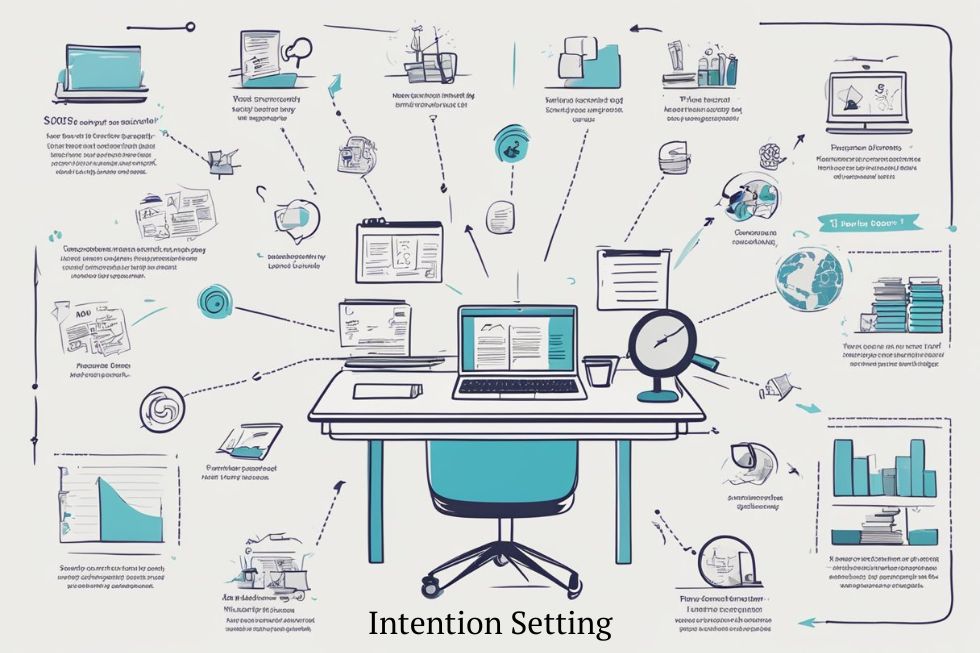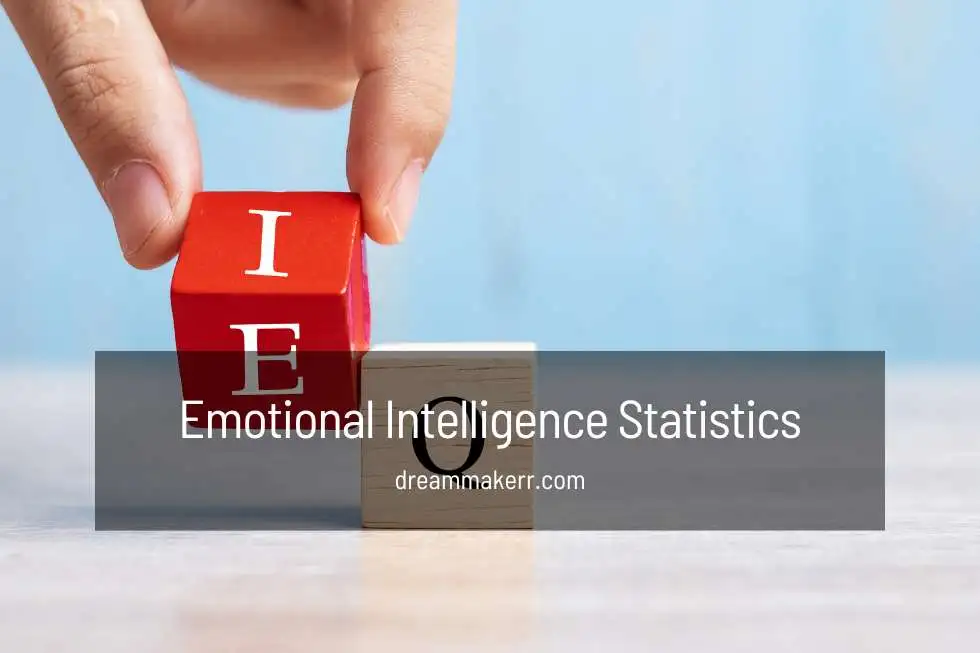On this page

5 Key Strategies for Effective Intention Setting in 2023
Learn what it means to set intentions, including the difference between intentions vs goals. Plus, how to stop ‘winging’ your goals with 5 key strategies to help set your intentions straight.
When we direct our energy towards an intention, it shapes our experiences and creates a reality that resonates with our vision.
Unlike goal setting, which often revolves around achieving outcomes, setting intentions is about aligning with our values and letting them guide our actions.
- Intention setting can bring clarity and focus to both our personal and professional lives
- The intention setting practice empowers us to live our lives on purpose
- It’s an insurance that keeps our behaviors and thoughts in line – with our goals and core beliefs
The recent increase in interest regarding the law of attraction and manifestation techniques has shed light on the importance of intention setting.
By incorporating techniques, like affirmations, expressing gratitude and mindfulness, the process of manifesting our dreams becomes more purposeful and deeply rooted in personal growth.
What Exactly Is Intention Setting?
Setting intentions involves identifying what someone aims to achieve. Or how they want to grow in their professional life.
It’s a practice that’s different from traditional goal setting.
- Definitions: An intention serves as a guiding principle for how someone wants to be, live and present themselves in the world. Unlike goals, which are usually focused on outcomes, intentions are more about the journey and the values that shape behavior.
- Key components: Effective intention setting requires self awareness, where individuals recognize their desires and aspirations. It’s important to strike a balance between ambition and feasibility ensuring that the intentions set align with reality.
Intention setting sets itself apart from goal setting by focusing on qualities one wishes to cultivate than tangible results. Intentions act as a compass guiding actions and decisions creating a path for personal growth.
What’s the Difference between Intentions vs. Goals ?
When we strive for achievements it’s important to understand the distinction between goals and intentions.
Here’s a breakdown of how they differ:
- Outcome versus Process: Goals are what we aim to achieve with results. They represent the endpoint of our efforts. On the other hand, intentions shape how we approach our goals and reflect our mindset and approach.
- Specificity vs. Adaptability: Goals tend to be specific according to stats, providing a roadmap with milestones. This specificity can make them less adaptable to changes. In contrast, intentions offer flexibility allowing individuals to adapt and grow based on their experiences as they pursue their aspirations.
- External vs. Internal Motivation: Goals can be driven by factors like deadlines or rewards. They prioritize achieving success. However intentions are rooted in values and a desire for self improvement focusing on the quality of the overall experience.
By understanding the differences between goals and intentions individuals can better plan their paths towards success by combining steps with a value driven approach to professional growth.
Related: The 10 Differences between Dreams vs goals
Step 1: Clarifying Your Goals

Setting intentions is a first step in the process of setting and achieving goals. You then turn intentions into actionable plans, setting final dates, making them more tangible and achievable as goals.
When it comes to defining goals it’s not enough to write them down.
They should be SMART; specific, measurable, attainable, relevant and time bound.
For instance, the intention of “losing weight “; a goal would be to “shed 10 pounds in 3 months by exercising three times a week and adopting a Mediterranean diet.”
Identify Underlying Reasons
Additionally, understanding the underlying reasons behind our goals can provide a boost in motivation and commitment. It’s important to ask ourselves what deeper values or desires our goals align with?
This understanding can also help us stay on track when faced with challenges.
For example, if our goal is career advancement the underlying reason might be to provide a life for our family.
Step 2: Developing a Plan of Action

When it comes to turning dreams into reality it’s crucial to have a thought out plan of action. This plan acts as a roadmap helping you translate your visions into steps.
Of focusing on how to manifest what you want the key question becomes; What steps should I take to achieve my goals?
Establish Specific Steps
To start with it’s important to identify and outline the specific steps that are necessary for moving from intention to action. Breaking down goals into more manageable tasks helps maintain focus and allows for progress measurement. For example if your goal is to improve your health specific steps could include things like scheduling weekly meal planning or setting aside time for exercise. Each step should be actionable , such as creating an effective action plan and directly aligned with the overall intention
Set Realistic Timelines
It’s also important to establish realistic timelines for each step.
Contrary to what may have been misinterpreted in movies like “The Secret” it’s not realistic to expect the manifestation of $500 million dollars, in 30 days.
That kind of expectation is simply a fantasy that needs to be let go of.
However, when timelines are practical and achievable they serve as motivation. They create a sense of urgency without the stress.
As an example, rather than making a goal to write a book within a month one could set a target to finish the outline in two weeks. Then write one chapter each week.
Timelines should take into consideration not the difficulty of the tasks but personal or external factors that may affect progress.
Step 3: Cultivating a Supportive Environment

Creating a supportive environment or mastermind group can help in effective goal setting.
It includes surrounding yourself with like-minded individuals or groups. You then use the community to help you stay on track towards achieving desired goals.
Engage a Community
Interacting with peers offers an opportunity to exchange strategies, discuss challenges and share success stories. These can not only be inspiring, but give practical ideas to use in your process.
For example, joining an online group that focuses on a common purpose can provide substantial emotional and practical support.
Make Use of Accountability Tools
Incorporating accountability tools into one’s routine helps maintain a focus on intentions. By utilizing Law of attraction planners and tracking apps one can monitor progress.
Identify areas that require improvement.
A tangible tool such as a habit tracker serves as a reminder. A motivator that ensures that your intentions remain prominent in daily activities.
Step 4: Practicing Mindfulness and Reflection

When it comes to setting goals it’s important to take a reflective approach in order to align our actions with what truly matters to us. These practices not only help us understand ourselves better but also keep us focused on achieving our intentions.
Integrate Daily Meditation
Incorporating daily meditation allows us to enter a state of heightened awareness where we can clearly define our intentions. This could involve focusing on our breath or using guided imagery to help center our thoughts. To make the most of meditation it’s beneficial to set aside a time each day and strive for consistency. As engagedmindfulness.org suggests, having clear intentions is vital and regular meditation strengthens this process.
Regularly Evaluate and Adjust
Another essential strategy is reviewing and pivoting our intentions. It involves assessing how well our daily actions align with the goals we’ve set for ourselves. By doing so we can track our progress and make any necessary changes along the way.
Mindful reflection as recommended by resources, like mindful.org helps us stay connected with our motivations and aspirations.
Step 5: Harnessing the Power of Visualization

Visualization is a great technique for setting intentions. It involves visualizing the desired outcome in your mind, which strengthens the connection between your intentions and actions.
Create a Vision Board
A vision board is a representation of your goals. To make one follow these steps;
- Collect images and words that resonate with your aspirations.
- Arrange these elements on a vision board template on your computer or digital platform.
- Place the vision board in a spot so you can regularly reinforce your intentions.
Using a vision board effectively helps bridge the gap between goals and tangible reminders thereby solidifying your commitment to achieving what you desire.
Utilizing Guided Imagery
Guided imagery is a practice where you listen to language to evoke vivid experiences in your mind.
To make the most of guided imagery consider these suggestions:
- Look for sources that provide audio recordings or scripts on visualization and intention.
- Dedicate some time to listen to these recordings and mentally visualize the scenarios described.
- Engage all your senses to enhance the images and strengthen their impact on setting intentions.
Guided imagery not only supports goal achievement, but also reduces stress, enhances clarity and focus towards reaching desired outcomes.
PRO TIP:
Set Daily Intentions
Starting each day with a morning routine can have a positive impact on what you achieve today.
Here’s what I recommend that you should do:
- Take some time in the morning to identify your goals for the day.
- Visualize yourself accomplishing those goals.
- Writing down these objectives in a manifestation journal or planner reinforces their importance.
- Affirming them verbally strengthens your commitment.
Final Thoughts
Intention-setting is transformative. It involves aligning your actions with your larger life goals. It holds the potential to greatly influence both your personal and professional journey.
The strength of your intentions lies in their capacity to bring clarity to what success means to you.
Why Broad Goals?
- Flexibility: Broad goals provide room to maneuver and adapt.
- Sustained Focus: They encourage continuous growth over the achievement of a single, narrow target.
The Importance of Positive Thinking
- Positive Framing: Approaching goals with a positive mindset increases the likelihood of achieving them.
- Visualization: Imagining success catalyzes actual success through the power of affirmations and manifestation.
Studies highlight the significance of establishing an objective indicating that it affects thoughts, feelings and behaviors. This method cultivates a sense of understanding enabling a driven way of living. By embracing a mindset focused on purpose you empower yourself to transform your aspirations into outcomes. It is the combination of aspiration. Foresight that allows us to approach what may seem unattainable, with potential, for achievement.
Sources Providing Further Reading
- Discover the 5 Steps to Manifest Someone in Your Life by combining psychological principles with intense script writing and focus.
- Explore 74 enlightening Secret Quotes by Rhonda Byrne that encapsulate the essence of her teachings.
- Learn about the effectiveness of 80+ Powerful I Attract Affirmations and how they can reprogram the mind towards success.
Frequently Asked Questions
In this section we will discuss some asked questions, about setting intentions and provide guidance to improve your intention setting journey.
What are the steps to formulate powerful and achievable intentions?
Developing achievable intentions requires having a purpose aligning with your personal values and being realistic about what you can accomplish. It begins with identifying goals that’re actionable and understanding the motivations behind them to maintain a strong commitment and sense of purpose.
How can one maintain focus on their intentions throughout the day?
Utilizing reminders like notes, apps, or accountability partners are also effective strategies. To stay focused, on your intentions throughout the day you can establish routines or rituals. For example starting your day with morning affirmations or setting aside time for reflection can help you stay on track and monitor your progress. Additionally using reminders, like notes, smartphone apps or having an accountability partner can be strategies to keep you motivated and accountable.
In what ways can intention setting lead to personal growth?
Setting intentions plays a role in development as it guides us, enhances our self awareness and encourages a proactive approach to life’s obstacles. It enables individuals to gain clarity about their aspirations and take actions towards accomplishing them.
What methods are recommended for teaching others about setting intentions?
One effective way to help others understand the importance of setting intentions is, by organizing workshops engaging in guided activities and sharing resources like articles that offer advice and real life examples of intention setting, in educational settings. The main goal is to inspire exploration and deep reflection.
Can you provide a practical example of what an intention might look like in daily life?
Here is a practical example of an intention that we can incorporate into our lives; “Every night, before going to bed I make it a point to recognize and appreciate at least three things that I am grateful for.” This straightforward practice of cultivating gratitude helps us take action and cultivate a mindset.

Petri Maatta is a mindset coach and neuroscience-focused author with 15 years of experience in personal transformation and success psychology. After seven years of business failures, he discovered the power of manifestation through a Fortune 500 mentor. Now, he shares neuroscience-backed strategies through DreamMaker membership, helping others transform their businesses and lives on their own terms.
Read My Story here.
Share This Story, Choose Your Platform!
You want to manifest a new car, but you’re wondering: Does this really work? Here’s
Many smart individuals are often linked with having a high IQ. However, according to emotional
According to online dating statistics over 90% of people believe in love at first sight,




